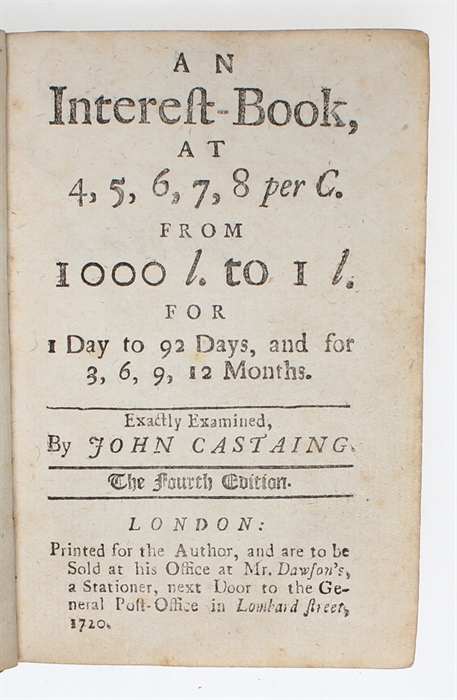INITIATING THE LONDON STOCK EXCHANGE
CASTAING, JOHN.
An interest-book at 4, 5, 6, 7, 8 per C. from 1000 l. to 1 l. for 1 day to 92 days, and for 3, 6, 9, 12 months. Exactly examined by John Castaing.
London, printed for the Author, 1720. Small8vo. (115 x 80 mm) Bound in a contemporary full calf with three raised bands and gilt margins to front and back boards. Extremities with wear and hindges weak. Previous owner's names to end paper and verso of title-page. Authors name in contemporary hand (in Castaing's own hand?) to upper part title-page. Internally fine and clean. [Blank], 88 ff, [Blank]. (A-I*8, K-L*8).
Scarce fourth edition of edition this earliest example of what came to found the London Stock Exchange, Castaing's famous pocket book for calculating interest. The book, which was advertised to be: "very exact, and convenient, not much bigger than a Spectacle-Case" quickly became immensely popular and was published in a total of nine editions. Despite of the many editions, all editions of the book are of the utmost scarcity, most likely due to the fact that it was intended to be a practical tool for merchants and bankers who daily had to look up interest rates, which will have caused the majority of the copies to be worn out.
We have been able to locate another copy with Castaing's name in a similar handwriting which could suggest it is either by the author himself or the publisher. We have, however, not been able to have this confirmed.
"This eighteenth-century version of Reuters, and its competitors were the sine qua non for the development of London into the major world financial center that it later became. For subsequent scholarly research,
Castaing’s publication also has proven highly valuable. If one event can be said to mark the completion of England’s transformation, however, it is the development of London to the point where it eclipsed
Amsterdam as an international financial center." (Lothian, Financial Integration over the Past Three Centuries).
During the 17th century, stockbrokers were not allowed in the Royal Exchange due to their lack of manners. They had to operate from other establishments in the vicinity, such as Jonathan's Coffee-House. At that coffee house, in 1698, Casting began listing the prices of a few commodities, exchange rates as well as certain key provisions such as salt, coal, and paper. Originally, this list was not daily and was only published a few days of the week. This constitutes the earliest initiative of what later became the London Stock Exchange.
(Goldsmiths' 6376 (1725 edition)); (Kress 2778 (1712 edition)). ESTC records 6 copies of this edition.
Order-nr.: 58354

